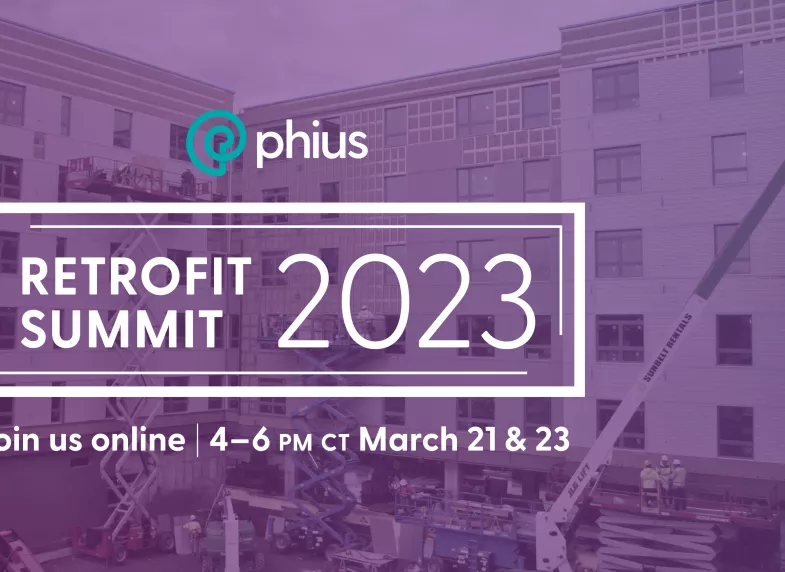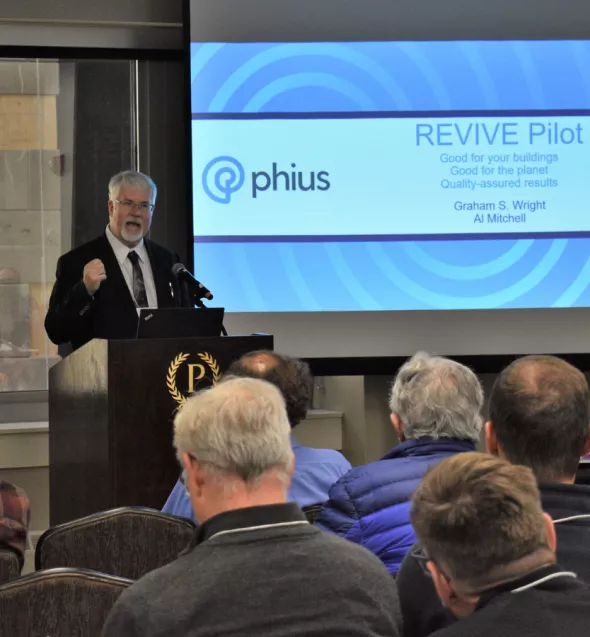A Sneak Preview of Phius REVIVE Pilot Ahead of Phius Retrofit Summit 2023
Phius Senior Scientist Graham Wright provides a glimpse inside the process of creating the new Phius REVIVE program for retrofits that is currently under development.
Phius Senior Scientist Graham Wright provides a glimpse inside the process of creating the new Phius REVIVE program for retrofits that is currently under development.

You may have noticed we’ve been telegraphing our intention to change our project certification program for retrofits for some time (we presented about it at our 2021 and 2022 conferences and wrote about it in our blog).
The upcoming Phius Retrofit Summit 2023 (March 21 & 23) will provide an update on these forthcoming changes to our retrofit program, while also examining some successful retrofit case studies. The challenge we’ve undertaken is to make retrofits practical in an enormous range of cases, and the new REVIVE Pilot program provides a path to make that happen.
Our current program holds retrofit projects to almost the same standards as new construction. The charge given to the Phius research department was essentially to reconsider that – to see if we could give retrofit projects more options in some sense. At the same time, the new program, the Phius REVIVE Pilot, should advance our mission of every building supporting the health of people and the planet. When we say every building, we mean it – that is the scale of our ambition.
The idea of more options turned out to have two or three senses. At first, it seemed to conflict with the idea of setting a certification standard at all: if there are a lot of options, what does the standard stand for? What’s the consistent meaning of the standard?
The first resolution to this is that there can be multiple compliance paths that have the same stringency in a well-defined sense like, equivalent in terms of some quantifiable performance metric(s). The second resolution is that there can be multiple tiers – a mandatory minimum level and optional higher levels.
The draft standard we will be presenting on the second day of the summit (March 23) and aim to release for public comment during the summit proposes what we believe are appropriate minimums in terms of decarbonization, sheltering people and limiting health risks from their buildings. For minimum sheltering we have used outage resilience criteria, and for health we have mostly looked to EPA. These are properties that every building should have and we will put forward bright line criteria.
The third meaning of “more options” basically had to do with building-to-building flexibility for customizing the details of the retrofit plan. Setting criteria on performance metrics tends to do that (some of you might be interested to see that we have circled back to the idea of setting some absolute targets on modeled performance metrics, because we think we have the right metrics on which to do that this time: the outage resilience criteria). There is also a relative-to-baseline performance criterion on life cycle cost that is sensitive to both embodied and operational carbon.

Our intent is to be transparent about the modeling protocol and to provide an input-file-driven calculation engine that incarnates it, based in turn on EnergyPlus, which is likewise open-source and input-file driven.
We were also keen to maintain the program feature of having a quality assurance process, and to set the stage to make that more open and scalable. For now though, it will be our Phius professionals delivering that quality assurance and they will have a lot of work to do because there are a whole lot of existing buildings and in the case of retrofits, there is an existing condition to be assessed and planned around.
We have looked to ASHRAE Guidelines for the basis of the quality assurance process. Their term for this is “commissioning,” which means not just post-construction verification testing, but encompasses the entire process from assessment and planning through construction and ongoing monitoring. We have cast Phius Certified Consultants (CPHCs®) in the role of Commissioning Providers (CxP). As in the current program, they will be doing modeling to performance targets, planning the retrofit with the owner, and submitting documentation.
The draft standard does not have tiers per se, but there are a number of a la carte electives, many having to do with stronger sheltering – fortification against site hazards such as flood and wildfire. If the owner opts for any of these, they are included in the quality assurance process. The CxPs are also involved in assessing the existing conditions and are responsible for rounding up documentation to submit for certification (or to the authorities, should any decide to adopt and administer the standard themselves).
Phius Certified Raters and Verifiers will be involved in on-site investigations of the existing conditions in addition to the mid-construction and post-construction verifications they do for new construction. A lot of what the Verifiers will be looking for in the existing condition are things that pose risks to indoor air quality according to the EPA.
The three bullet pitch for the program is therefore:
The pilot phase of the program will last for some time and will likely see some adjustments to the stringency based on immediate feedback and pilot projects.
Myself and other members of the Phius research department heading up the development of the new program will be presenting March 23 on Day 2 of the Phius Retrofit Summit 2023. Join us for the full summit to learn more about the future of the Phius REVIVE Pilot, and hear from a panel of experienced Phius professionals who will be sharing retrofit case studies March 21 on Day 1 of the summit.